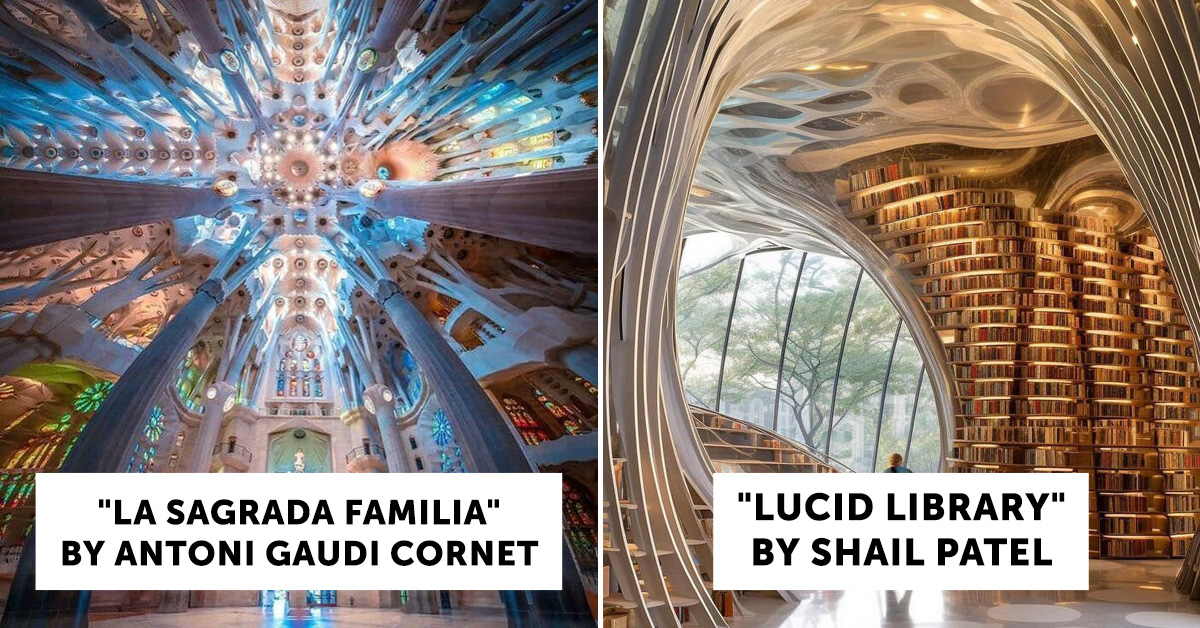35 Dazzling Displays of Parametric Architecture Unveiled By Enthusiasts In This Facebook Group
Parametric architecture, huh? For those who might be scratching their heads, it’s a cutting-edge architectural approach that leverages algorithms and digital tools to design and produce uniquely crafted structures. Have you ever seen Beijing’s iconic Bird’s Nest stadium or London’s Serpentine Pavilion? Yep, those are stellar examples of parametric architecture in action.
Now, if you’ve got an appetite for more, there’s this super-cool Facebook group for enthusiasts that just dropped a collection of mind-blowing pictures showcasing the best of the best. Whether you’re an architect yourself, a design lover, or just curious, these examples of parametric architecture are sure to captivate and inspire.
#1
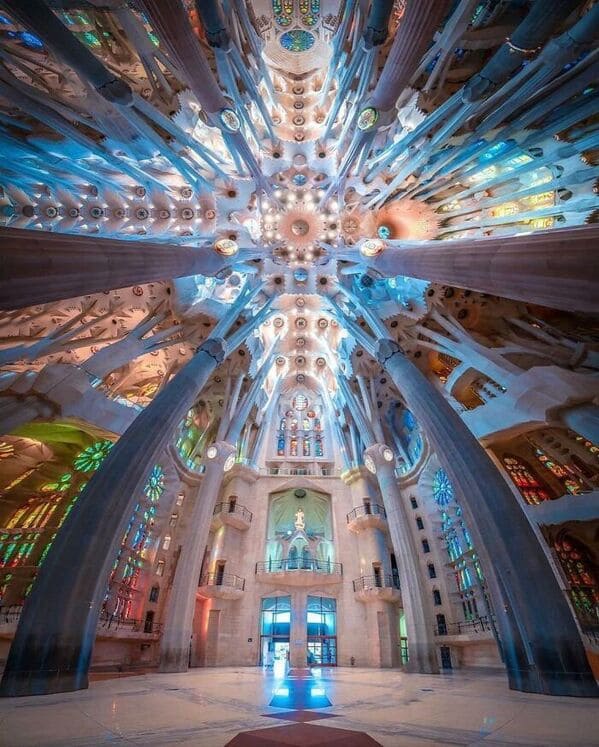
The Catalan architect Antoni Gaudi Cornet is considered to be the greatest architect of the twentieth century. He is known for creating architectural masterpieces which have an artistic/creative design innovation. The majority of his designs have been influenced by nature and mathematics.
Gaudi’s masterpiece project, the La Sagrada Familia is still under construction, with completion expected in 2026. He worked on the project until his death in 1926, in full anticipation he would not live to see it finished.
La Sagrada Familia utilizes three-dimensional forms comprised of ruled surfaces, including hyperboloids, parabolas, helicoids, and conoids. These complex shapes allow for a thinner, finer structure, and are intended to enhance the temple’s acoustics and quality of light. The interior of the church is like a stone forest, a kaleidoscope of colorful lights and shadow.
#2
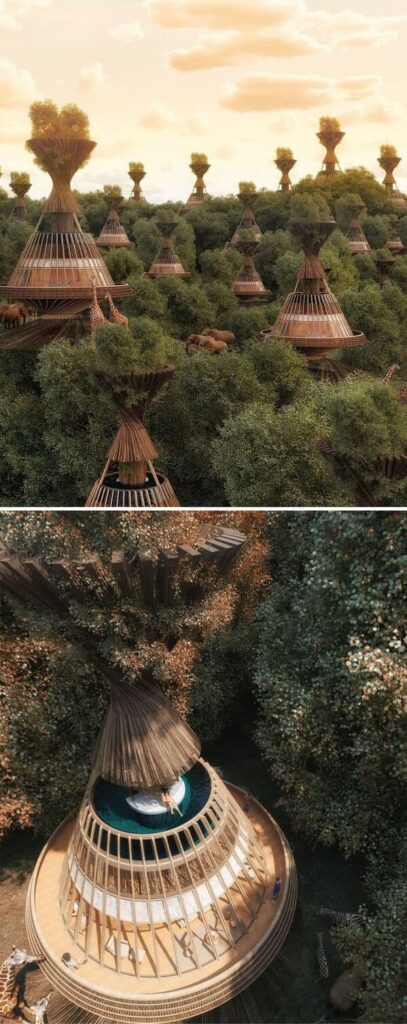
MASK Architects has designed the world’s first eco-tourism-based safari resort in Africa which creates its own water autonomously by using “air to water technology” energy powered by transparent solar device covered curtain glass and envisions creating a sustainable ecological community in Africa.
The aim of the project is not only to make a unique luxury residence but also to seek innovative, sustainable, and environmental solutions to problems based on constructive and restorative project generation processes arising from the geological, climatic, and environmental factors in which the project is located.
#3
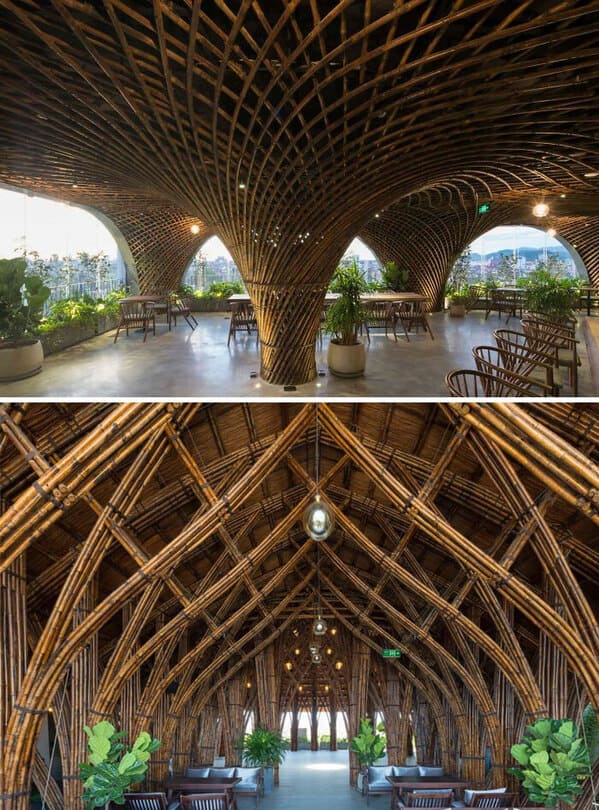
VTN Architects – Myanmar creates a “Cave-Like” Nocenco cafe with a swirling bamboo ceiling in Vinh City, Nghe An, Vietnam.
#4

Designed by internationally renowned practice Snøhetta, Under is an impressive underwater restaurant located at the southernmost point of the Norwegian coastline. A unique confluence where the sea storms from the north and south meet, providing a natural abundance of biodiversity. This restaurant not only offers a stunning panoramic view of marine life but also functions as a research center for marine life. From the oak-clad foyer to the bespoke textile-clad interior, every detail is crafted with care.
Photos by Ivar Kvaal.
#5
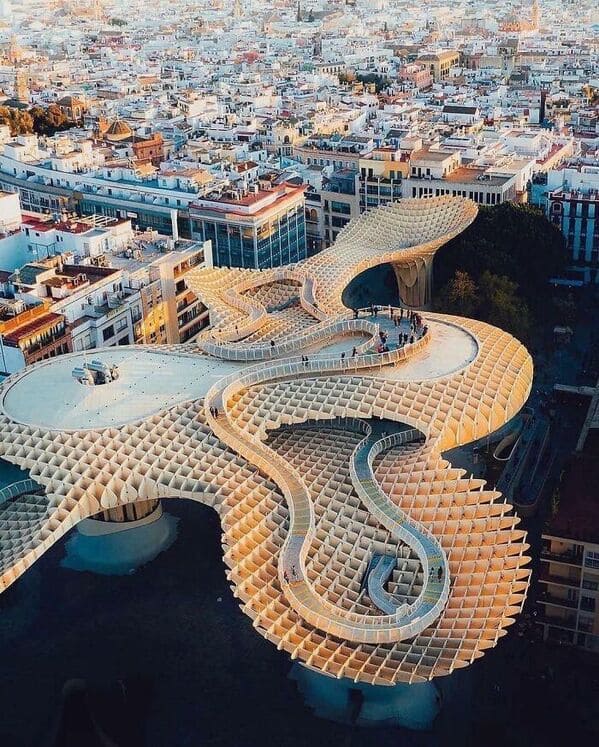
The wooden structure of the Metropol Parasol, Jürgen Hermann Mayer, Seville, Spain.
#6
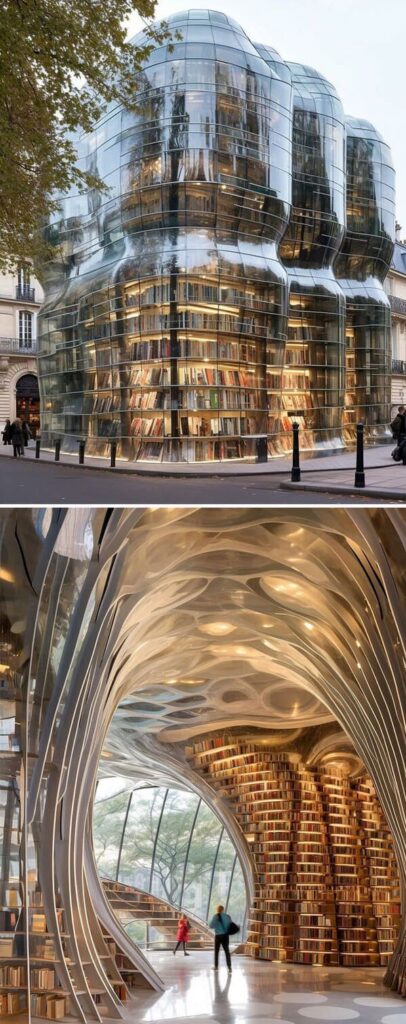
“Lucid Library” concepts by Shail Patel.
#7
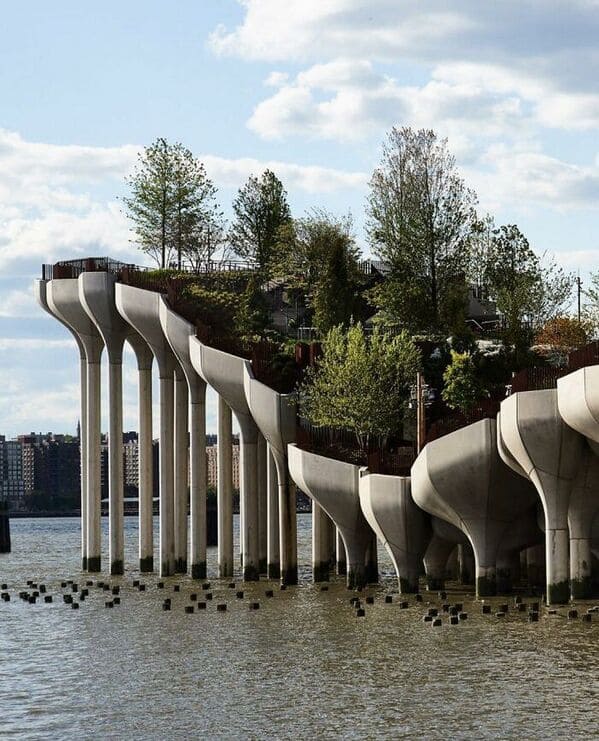
The Little Island: Blossoming Greenways designed by Heatherwick Studio opened to the public in New York. Resembling tulips rising in varying heights enthrall to capture magnificence and drama.
Thomas Heatherwick’s Pier 55 park within New York’s Hudson River renamed as Little Island sparks waves among the citizens. Visuals reveal cast-in concrete planters lifted by cranes to sit atop poles in the water.
#8
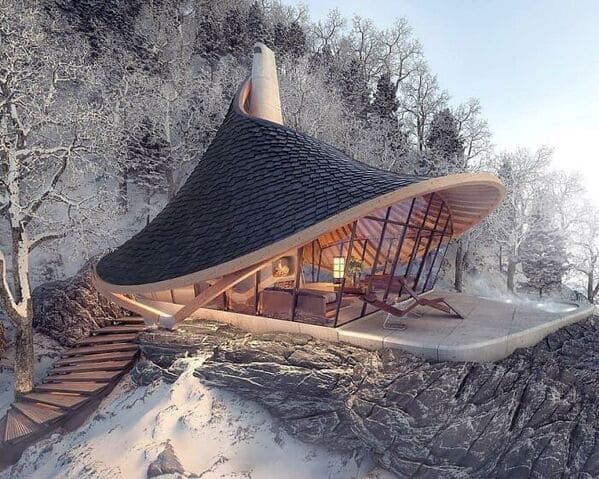
Designers Kristof Crolla & Julien Klisz visualized the YEZO as a retreat center for the idyllic Hokkaido in Japan. The project is designed with an experimental design approach to create a sanctuary in nature and to use the dramatic landscape of the surroundings.
The YEZO’s overall design is a fusion of both aesthetics and algorithms, optimized for fabrication from one single mold to minimize ecological impact and reduce manufacturing cost and delivery time.
#9
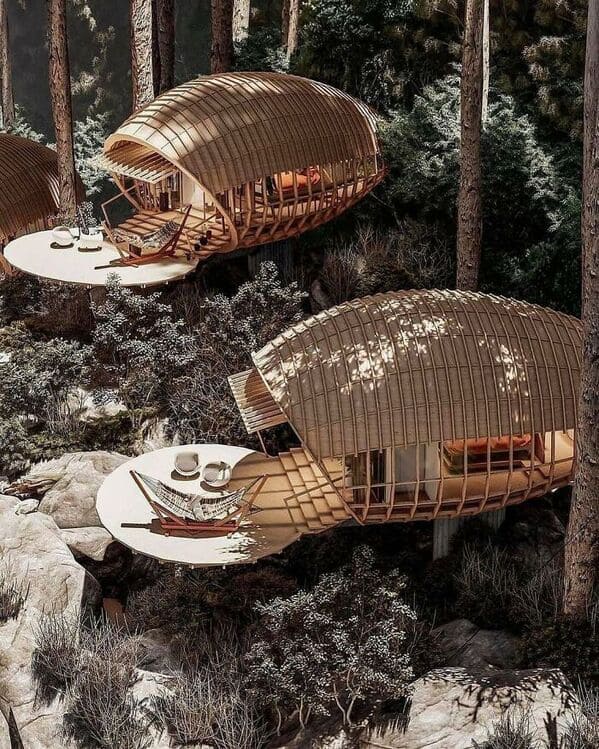
Architect @veliz_arquitecto has visualized a series of cabins on a mountaintop to serve temporary visitors. These cabins with their unique wooden structure are uniquely attached to the surrounding environment of the mountains.
#10
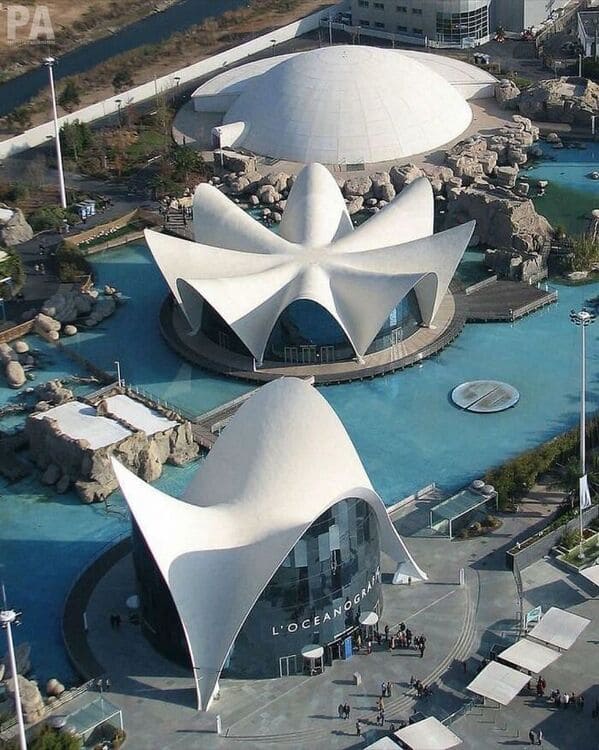
Hyperbolic parabola structures of the L ́Oceanogràfic in Valencia, Spain designed by Felix Candela. Spanish born architect Felix Candela used thin-shell reinforced concrete to create his signature hyperbolic parabola structures. L’Oceanographic was his final project, which was completed posthumously (1997).
Félix Candela is one the greatest architects of the 20th century. Candela was known as being able to transform concrete into visual poetry with his structural design based on hyperbolic paraboloids, or thin-shell structures, as they were more often called.
#11
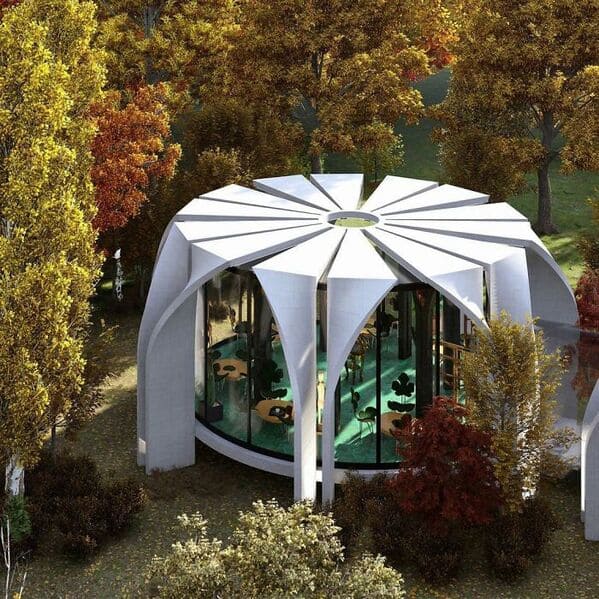
REMM Studio designed a modern coffee house which inspired by traditional Iranian architectural forms such as arches. The Coffee House structure is circular in shape to provide a 360-degree view of the surrounding forestry environment.
The concept design process began with the simplification of the previously mentioned forms; the shape of the arches was changed into three dimensions, and a new module was obtained. This module is repeated in a circular pattern around the central axis.
#12
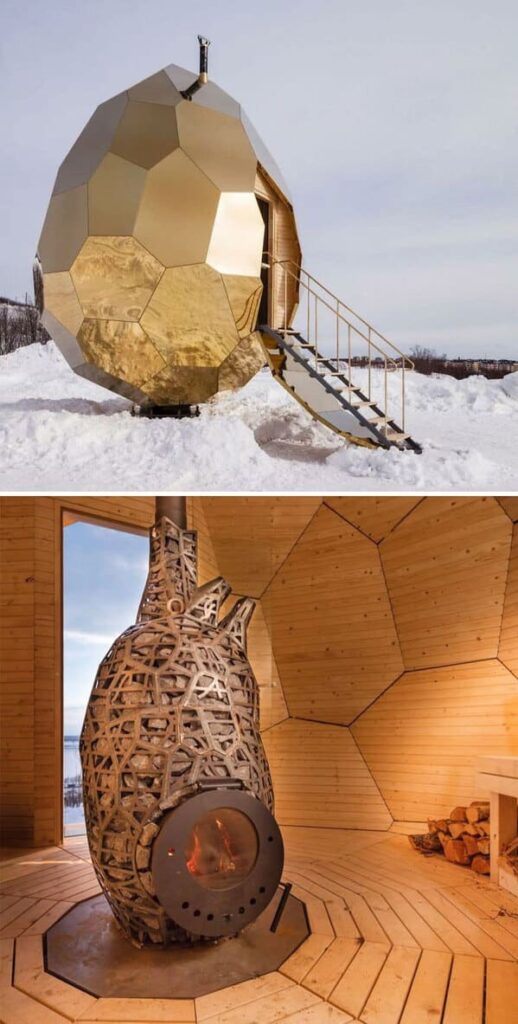
Step inside the sculptural sauna in the form of a golden egg-shaped chamber created by artists Bigert & Bergström in Kiruna, Sweden. Solar Egg is comprised of 69 separate pieces of gold-plated stainless-steel sheets, which come together to form the multifaceted oval. Located 145 kilometers north of the Arctic Circle in Swedish Lapland, the egg-shaped form is intended to make reference to the climate, with the snowy surroundings reflected in the golden mirrored surface.
Picture: Jean-baptists Béranger
#13
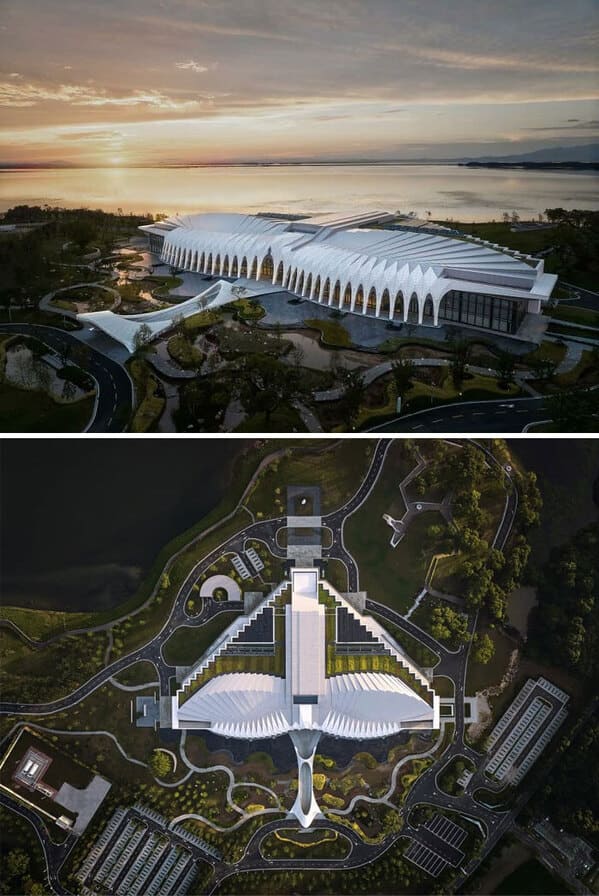
Building For The Birds: International Migratory Bird Town Convention & Exhibition Center By OI Architects.
#14
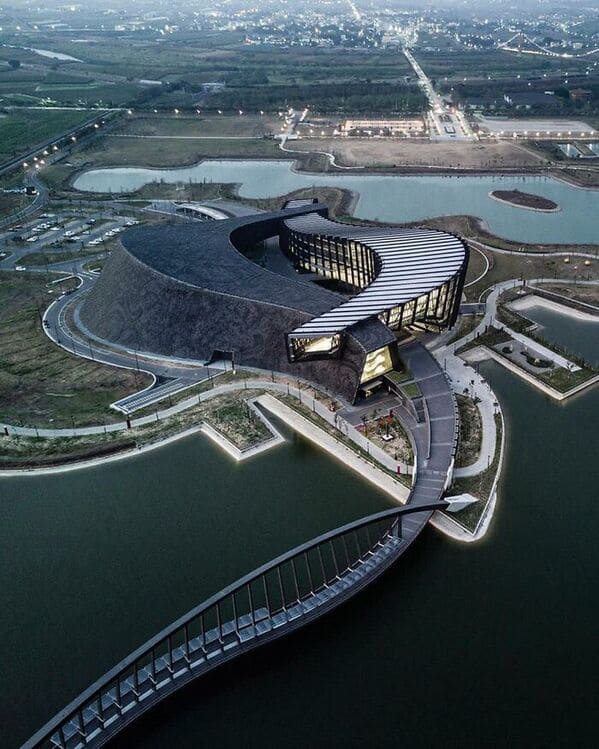
Southern Branch of Taiwan Palace Museum, designed by KRIS YAO l ARTECH in Taibao City, Taiwan, is composed of three distinct sculptural fluid forms representing three Chinese calligraphy strokes: the thick ink, the half-dry, and the smearing. All three forms have different functions. The solid form contains the curatorial department and exhibition halls; the glass-and-steel “void” volume houses the museum lobby, café, library, and administration offices; the third smearing stroke flows through intersecting solid and void forms, connecting spaces with a smooth circulation pattern. The curved pedestrian bridge, which is an important part of the design, allows visitors to enter the museum from under the glass volume. The exterior of the solid form is covered with cast aluminum disks attached to the curved surfaces.
by Shawn Liu Studio, Kyleyu Photo Studio, Jeffrey Cheng
#15
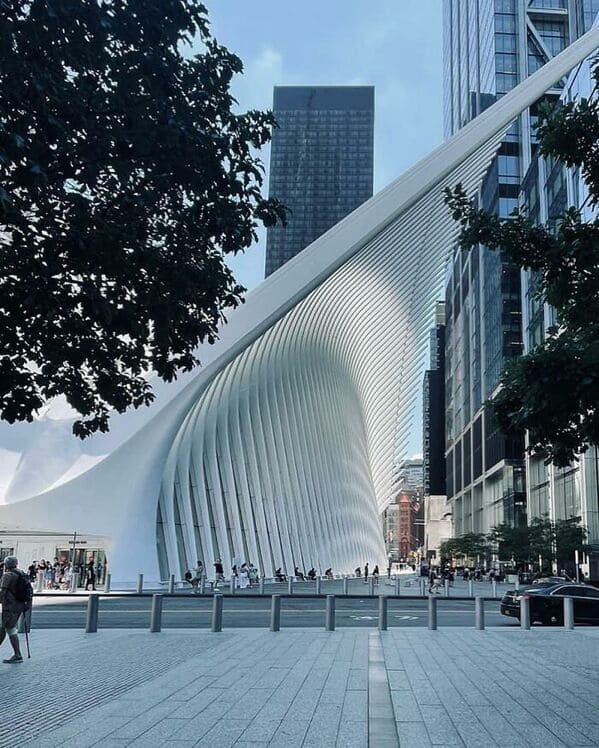
The Oculus in New York City, an architectural marvel by Santiago Calatrava LLC represents the city’s strength and a beacon for resilience.
Picture: Shannon Demicoli Battisson
#16
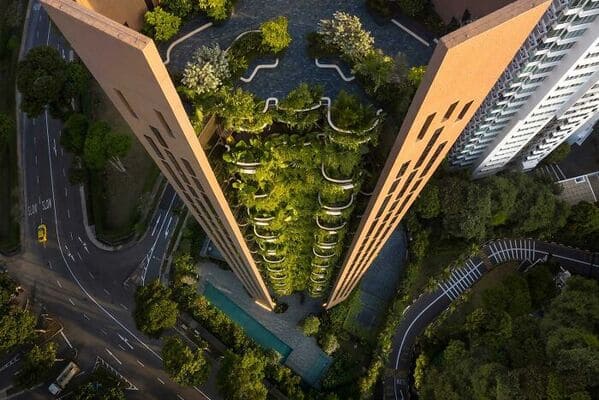
Heatherwick Studio’s EDEN Represents a Unique Way Of Living In Singapore.
#17
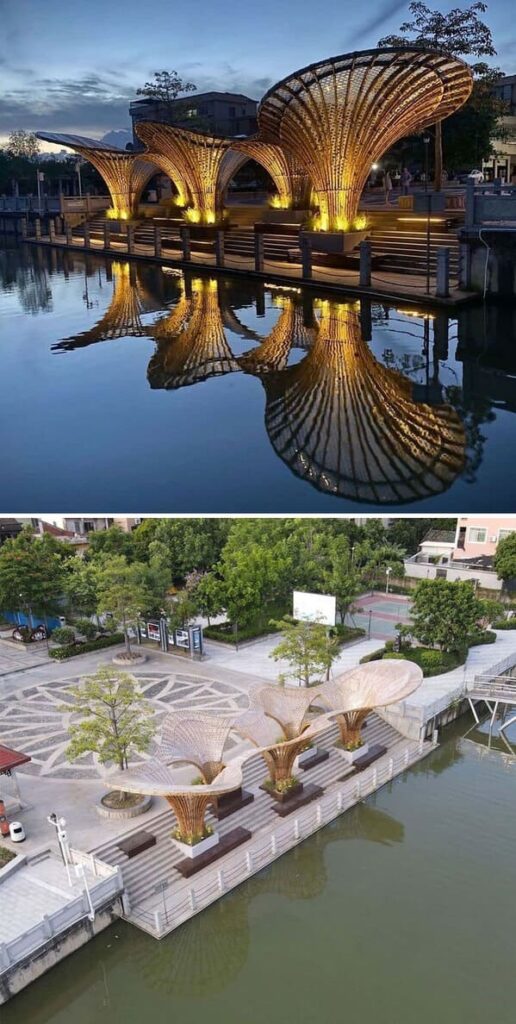
Huanglong Waterfront Bamboo Pavilion by Atelier cnS + School of Architecture, South China University of Technology. Architects designed a waterfront bamboo Pavilion at the waterfront steps, hoping to provide a cool place for residents and tourists who enjoy the water culture of Huanglong Village.
The waterfront bamboo corridor adopts a double-side cantilever method, utilizing the toughness of the original bamboo to realize the integrated design of the structure and facade. Combined with the steps, it provides the maximum waterfront grey space. The Bamboo Pavilion is multi-functional, integrating recreational space, water theatre, and wharf in one and activating the new look of Huanglong Village.
Picture: Ruibo Li, Li Chen
#18

The Twist Museum is BIG – Bjarke Ingels Group‘s sculptural form in Jevnaker, Norway, revealing a beam that bends at 90 degrees while visitors wander the park-specific works of international artists such as Anish Kapoor, Olafur Eliasson, Jeppe Hein, and Fernando Botero cross the Twist to complete the art tour.
The simple twist in the building’s volume allows the bridge to rise from the lower, forested shore in the south to the hillside area in the north. Accessible from both sides, the building offers an uninterrupted path through the landscape. The structure, which functions as a bridge and an exhibition hall, consists of flat aluminum panels. White panels repeat themselves in the interior with white fir slats.
#19
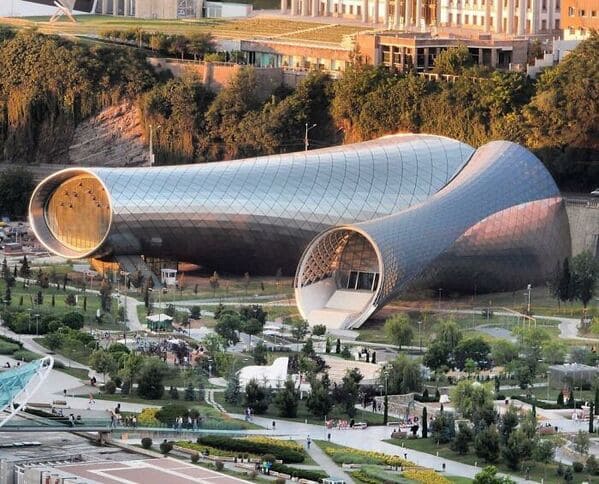
Park Music Theatre and Exhibition Hall; Located in Tbilisi, Georgia, and designed by Massimiliano & Doriana Fuksas, the building’s reptile-like form makes reference to amplifiers that carry the music out of the chamber.
The building consists of two different soft-shaped elements that are connected as a unique body at the retaining wall. Every element has its own function: The Musical Theatre and the Exhibition Hall.
#20
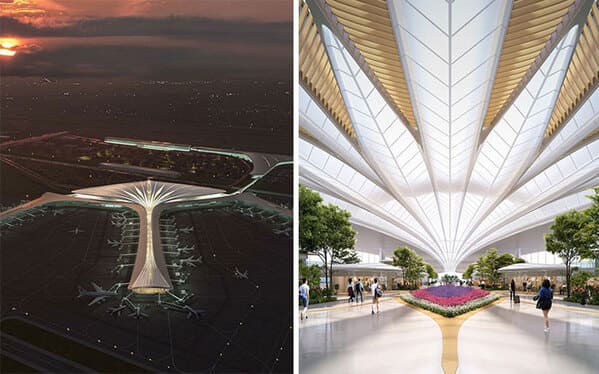
Chinese practice, MAD Architects reveals its winning design for the new terminal of Changchun Longjia International Airport in China. The terminal building is designed like a floating feather and, the long curve of the roof truly reflects the moving lines and spaces inside the airport.
#21
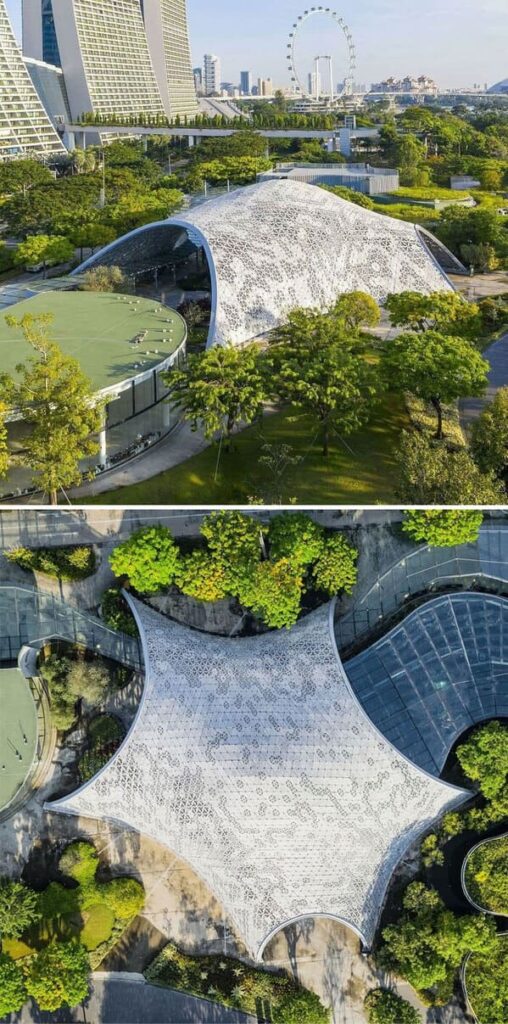
The Future of Us Pavilion, located in Singapore between Marina Bay Sands and Singapore’s Gardens, was designed for the Ministry of National Development on Singapore’s 50th Anniversary capstone event by Advanced Architecture Laboratory SUTD.
The design follows the traditional architectural structures that blend an intricate perforated skin form fluidly with the adjoining environment. The pavilion became a permanent landmark that serves as an essential public asset and venue for major public events. At the same time, it contains a range of cultural events, continuing its role as a public asset for the years to come.
Architect: SUTD Singapore University of Technology & Design
Location: Singapore
#22
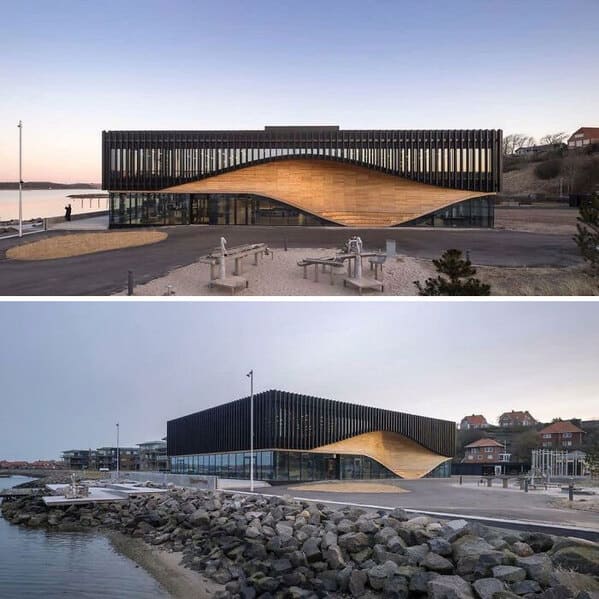
3XN and SLA designed the Klimatorium as an innovative and creative mini-hub for storm surge, water, and climate research.
One of the main symbols of the building is a wooden ‘wave’ that rises above the main entrance and makes the building an easily recognizable landmark.
Located in Lemvig of Denmark, the motif is inspired by the city’s characteristic fishing boats and is a tribute to the area’s cultural history and local building customs.
Picture: Adam Mørk
#23
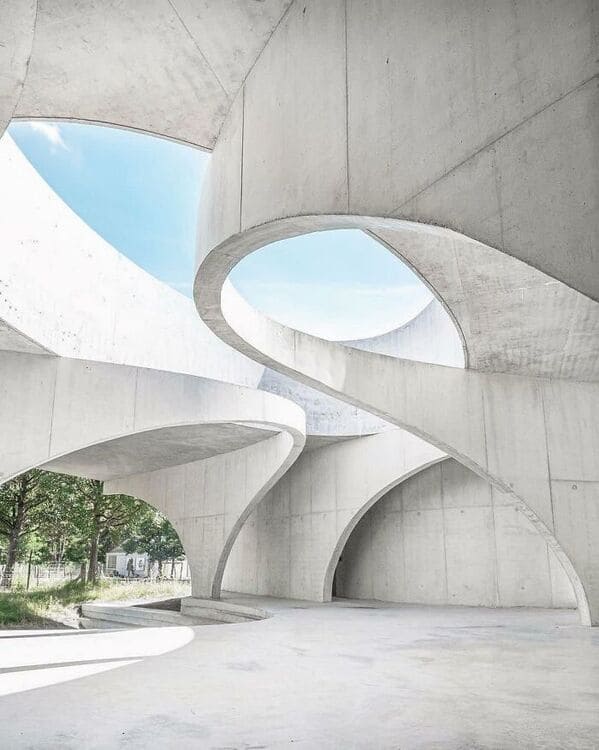
Amazing shot from the concrete curvatures of the LabOvo, Labiomista, designed by Belgium-based practice Van Belle & Medina Architects in Genk, Belgium / 2018.
Picture: Victor Dumont
#24
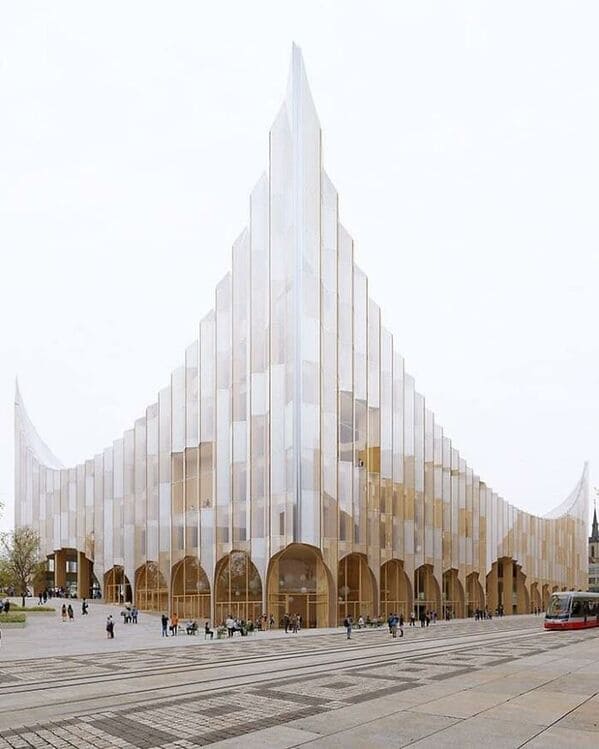
Henning Larsen’ proposal for Vltava Philarmonic Hall is a distinctive, practical, and low-impact design, as well as a world-class musical experience for future generations, using a mix of steel, concrete, and mass wood materials. The structure is divided into three major volumes, each of which is built as a self-stabilizing concrete structure–a ‘box in a box’ idea –with concrete walls and concrete cores to reduce sound transmission from outside to inside and vice versa.
Architect: Henning Larsen
Location: Prague
Visualizations: Sora
#25
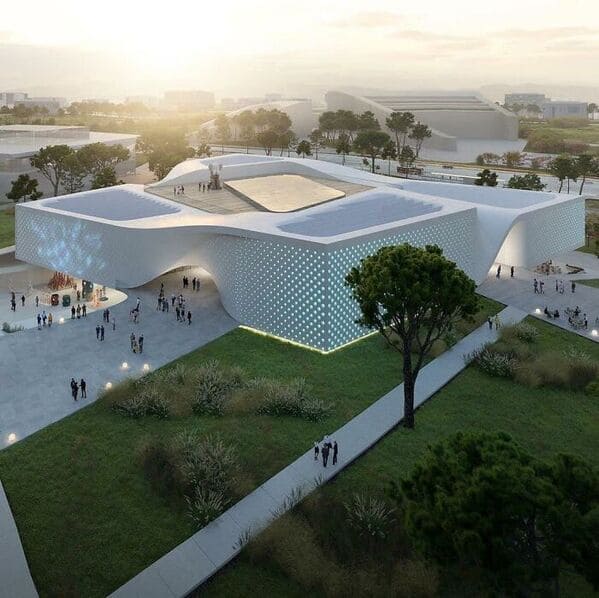
UNStudio’s winning proposal for the Chungnam Art Museum in South Korea goes far beyond a traditional art museum. Designed in collaboration with DA Group, the museum is a fully immersive cultural and social experience for the entire community. Set to be a living, breathing space that will grow and change over time, the museum is designed as a place of inspiration, participation, and contribution to both the art and local communities. The project also aims to become one of the first Zero-Energy museums in Korea.
#26
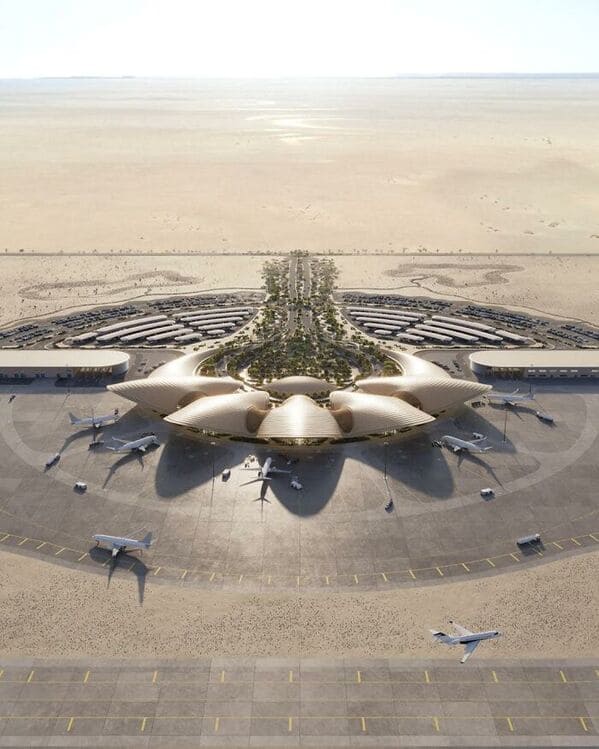
Saudi Arabia’s Red Sea International Airport is set to open by the end of this year.
#27
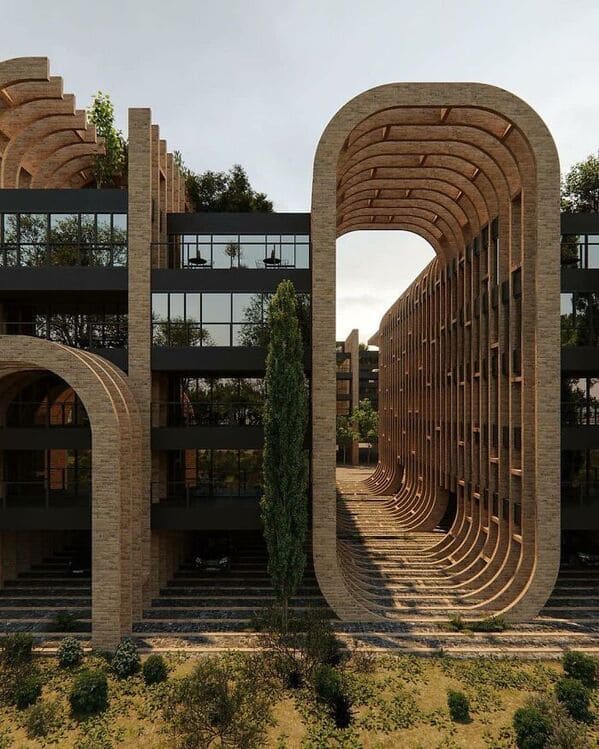
The recent design proposal by fmzd for the Andisheh Housing.
Architect: Farshad Mehdizadeh
Photographs: Mohammad Jokar
#28
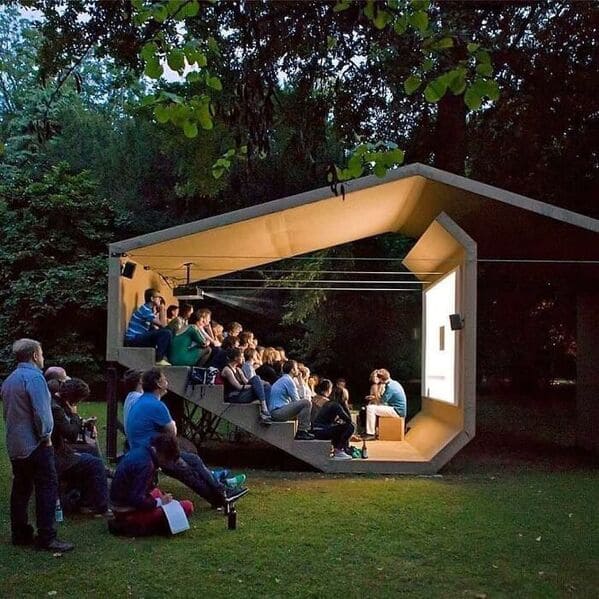
Cineorama by Erika Hock is an outdoor viewing space, so you can sit and watch a couple of your favorite movies with your family and friends, within the comforts of your own backyard.
#29
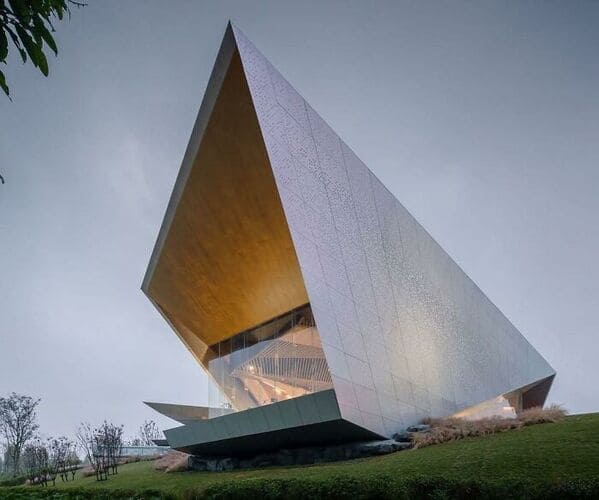
Chongqing LongFor – Hall of Waterfront City by Shanghai Tianhua Architecture Planning & Engineering. Ark of Light City Exhibition Hall, which covers an area of 950㎡ (floors area, with a site area of 20000㎡), is located at the commercial core of Lijia new area, the riverbank of Jialing River, and the new center of Chongqing, next to the only waterfront low-density business district of Chongqing and top residential area in the future.
The concept of the future is presented by the sense of antigravity, combining the tactility of fine gauze. To achieve that, architects used the method of parametric design when they dealt with that perforated aluminum panel, where holes in diverse scales actualized the initial concept of fine gauze. Under the gallery frame, they elaborately picked a stainless steel plate with mirror coating as the gallery’s surface, and the result turned out to be like a galaxy with mini holes on plates and lightboxes in the dropped ceiling.
Yubei Qu, China
Picture: Shengliang Su, Yang Yuan
#30
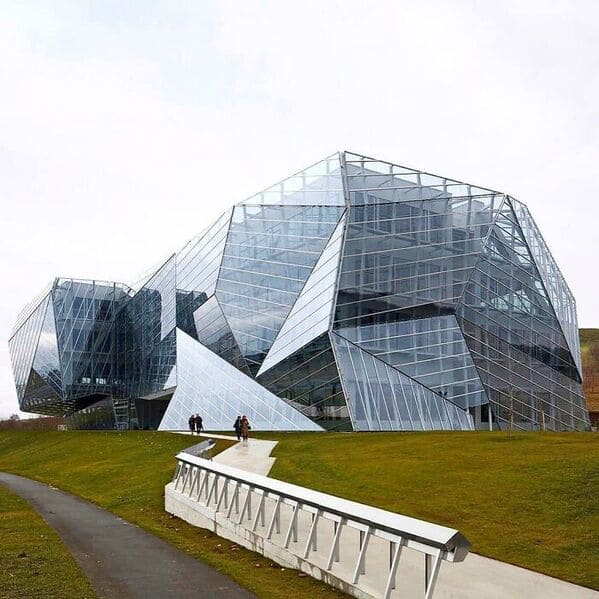
The E8 building by Coll-Barreu Arquitectos was designed as part of Alava Technology Park’s expansion, and is a transformable architecture which can adapt to various uses.
Located in Vitoria, Spain the building implements a two-layered climate control strategy with an isolated internal shell and a ventilated exterior, providing significant energy savings and reduced emissions by distancing the interior from extreme outdoor temperatures.
#31
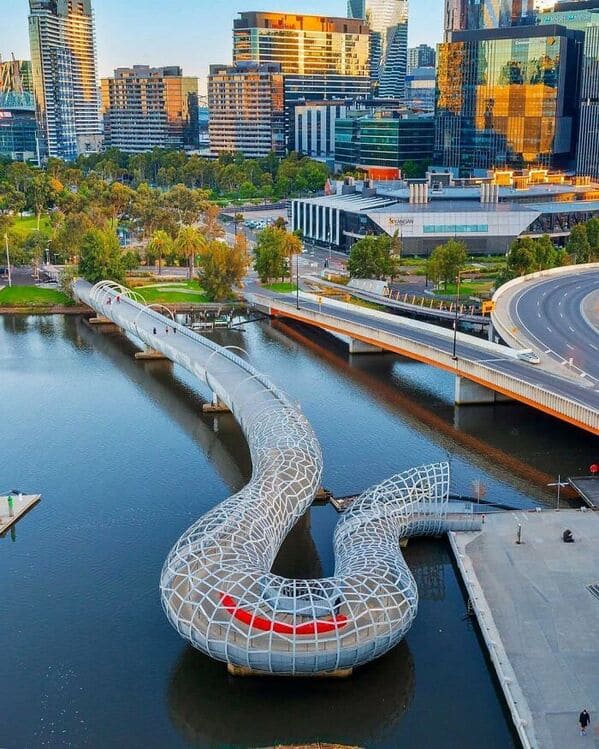
Designed by Denton Corker Marshall in collaboration with artist Robert Owen, the Webb Bridge in Melbourne comprises two distinct sections: the existing structure (145m long) and the new curved, ramped connecting link (80m long) employed to take up level changes, creating a point of arrival at the south bank.
The new Webb Bridge allows users to appreciate the surrounding views and activities along the river. It can be used as a destination in its own right, as well as a meeting point, or simply, a place of leisurely contemplation. As an object, it appears as a delineated structure, a sensuous volume, light and linear. Space is seen as atmospheric, dynamic, and transitional.
Photo: Walking Perspective, John Gollings, Shannon MacGrath
#32
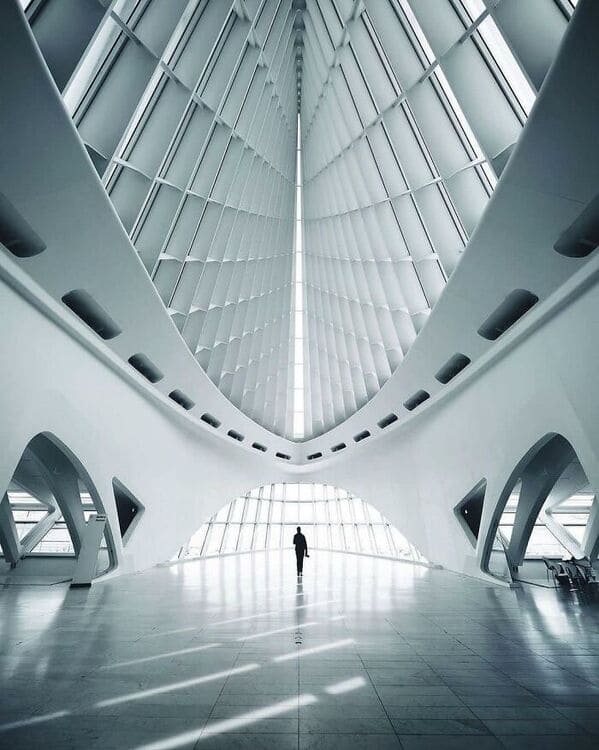
Stunning interior shot from Santiago Calatrava‘s Milwaukee Art Museum in Wisconsin, USA.
Photo by Hayden William Eakins.
#33
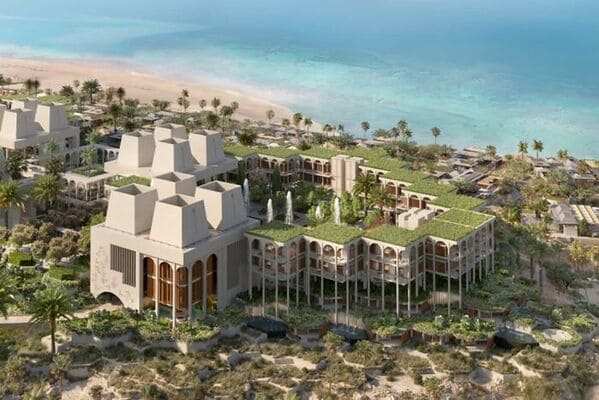
John Heah’s Masterful Design For Clinique La Prairie Resort In Amaala, Saudi Arabia.
#34
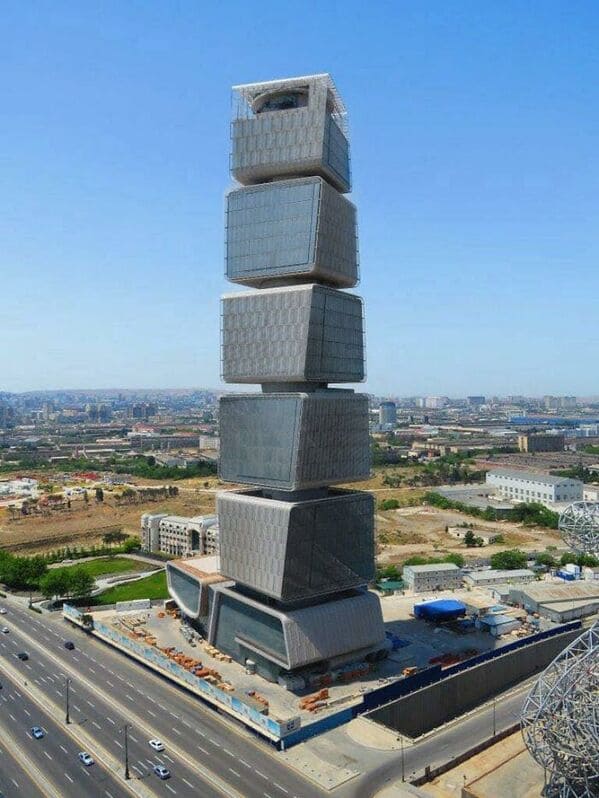
Azerbaijan Ministry Of Taxes Tower By FXCollaborative Features A Spiraling Design.
#35
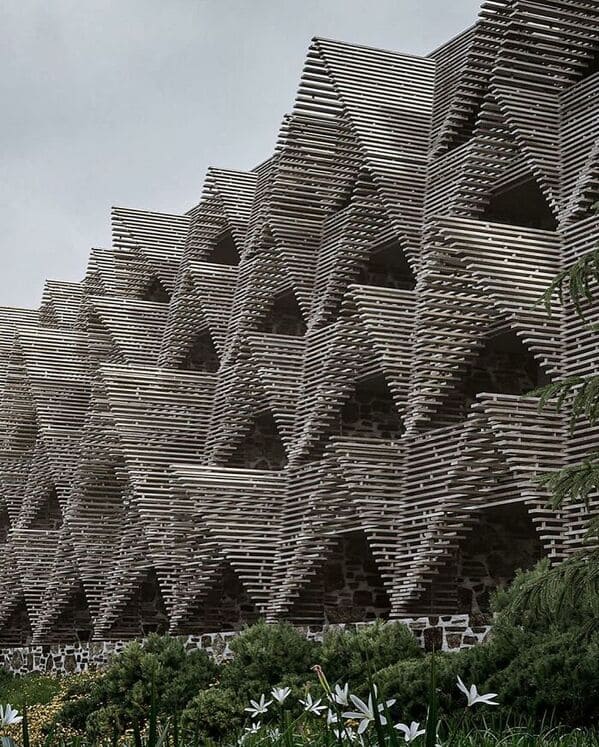
Hotel Natura Extension is designed by ENOTA as a part of the touristic resort in Rogla, Slovenia.
The designers aim to “connect the unconnectable,” integrating the eye-catching facade with the roof. The facade is visually transformed into a timber gable roof, historically characteristic of the environment. The timber on the facade is freely stacked and unprotected, allowing it to age and coalesce with the appearance of the surrounding landscape.

